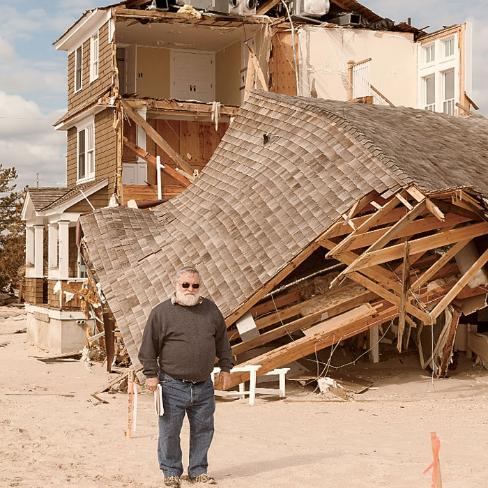Kung Fu, Consciousness Change, and Sandy One Year Later
categories: Cocktail Hour
1 comment

Orrin Pilkey in Mantoloking (Photo by Jeremy Lange)
Today marks a year since Sandy hit the East Coast. The natural media tendency is to look for “lessons” on the anniversary of any big event. I won’t go that far but it is fair to say that I have noticed some changes since Sandy. When we followed the path of Sandy last February, Orrin Pilkey and I talked about how we were encouraged by the fact that suddenly people were at least talking about ideas that no one had been talking about during our earlier trips on the coast Maybe what was is surprising isn’t the fervor to re-build on the coast–that is same old, same old–but that this time there were actual murmurings about not re-building, and that those murmurings became official with the offer by New York State, backed by Governor Cuomo, to buy land and homes that was in the danger zone. Even the vain Weather Channel jocks, so proud to always be the only ones standing out in the storms (and so outraged when mere civilians dare to go outside and stand next to them) have begun to admit that things like climate change and stronger storms might just be real after all.
As for the damage from the storm itself, it was staggering, even when I saw it four months after Sandy hit. Here are some images taken my the photographer Jeremy M. Lange, who travelled with Orrin and I up the coast: A Sandy Gallery
And here is an excerpt from my Outside magazine piece of the moment when Orrin and I saw the worst of it:
All talking stops when we reach Mantoloking. Four months after the storm and the place still looks like it just survived aerial bombing. The signs of devastation here make that on Long Beach Island look mild. Crumpled houses, houses floating out in the bay, houses cracked in half with their innards—TVs, rugs, lamps, books, and in one even a comfortable looking easy chair—revealed, as if this were some giant’s diorama of a human habitation. All this time passed and the homes remain deserted, the power still off. Huge mansions lie splintered, and, on the bay side, formerly deep-water docks now float not on water but sand and debris.
We park in the middle of town, which has been wiped clean. Here the water breached on the ocean side and tore through to Barnegat Bay, creating an inlet where none had been, and sweeping everything in front of it into the Bay. A corrugated steel wall now serves as a bulkhead where the water rushed through.
State police watch from every corner, keeping drivers from stopping and gawking, and, of course, from looting, which was a problem here early on. We procure a press pass and walk down the devastated streets. The first house we come to slumps into the bay, half on land and half on water, and the second lacks a front wall: we peek in at a dining room where everything is shattered except for a still-hanging chandelier. Out in the middle of the bay a house floats, flying a flag and listing to starboard.
Cathy Totin tells us that she cried last week when she first saw this. While Orrin isn’t crying, he isn’t exactly gloating either. In fact, overall Orrin has more sympathy with these residents than those of the Outer Banks, since here they had no historical reason to expect such a storm. Implied in this is the fact that he won’t be as sympathetic next time.
Her son Matt points out that there’s always a certain element of randomness to hurricanes.
“Look at this house,” he says. “It’s untouched. The grill still sitting in the backyard. And now look at this one.”
He points to the house next door, or what is left of it. It looks like it has been chopped up into tiny pieces by a team of manic lumberjacks. He says that he came to this beach to surf as a kid but that most of the landscape is now unrecognizable, having been re-designed and reordered by the storm.
“The rich got hit the hardest,” Orrin says. ”The best houses got it worst.”
It’s true. Those who chose to live right next to the sea got to learn a little about the consequences of doing so.
I wander off alone down to the beach. I’ve said that I’m against military metaphors, but maybe it’s impossible to talk about something like this without them. Here tattered American flags fly from the top of crumpled buildings, and without thinking I find myself using words like “Ground zero,” “attack,” and “battle.” I even briefly pity the poor politicians who opposed the billion dollar boondoggle of relief that passed right after the storm, and who finally caved even though the relief bill contained money for fisheries in Alaska and dredging along the Mississippi. No matter. You didn’t want to get caught using words like “retreat” right after Sandy.
But to temper this I remind myself that most of these houses are second homes, vacation homes. The rich got it worst, as Orrin says. And in the end the military metaphors simply don’t wash. The ocean isn’t really the enemy: no one wants to “defeat” it (and no one with any sense thinks they can). In fact, people move here precisely because they like the ocean, its wildness and beauty and uncertainty. True, they like it in controllable doses, certainly not in the dose they just got it in. But the larger point is that the sea is not Grant’s army laying siege to Vicksburg. It’s an elemental force that has been doing the same steady work for eons. Is it unpatriotic to suggest that respecting that primal force, even getting out of its way, is a better idea than fighting it?
“One guy up in Mantoloking has his house up on stilts already,” Matt told me earlier. “Everyone bitched and moaned about the way it looked. But his house survived.”
 The water flowed through it of course. This may be the central lesson of coastal living: don’t block the flow. It occurs to me, not for the first time, that anyone concerned with living on the coast should sit down with a big bag of popcorn and watch re-runs of Kung Fu.
The water flowed through it of course. This may be the central lesson of coastal living: don’t block the flow. It occurs to me, not for the first time, that anyone concerned with living on the coast should sit down with a big bag of popcorn and watch re-runs of Kung Fu.
Everything is ephemeral, Master Po might tell Kwai Chang Caine, nothing lasts. And of course we know this on some level. These houses are child’s castles in the sand waiting for the next wave to roll in. And yet… and yet most of us don’t—and maybe can’t—live that way. We bolster that castle. Build our lives around it. Maybe put in a two car garage or a pool out back. Treat that castle like it will be here forever.
The trouble is that during the thousands of years of human existence on earth, living by the sea has always been a gamble, carrying with it the decent chance of being wiped out. That’s why the shore was often merely a migratory destination, a place to move to during the milder months and away from during the stormy ones. Humans built shacks, knowing they might be wiped out. But now we have chosen to build castles instead, this seemingly insatiable drive for more coming from the same root drive that leads us to burn fuel like drunken pirates, the very thing that is leading to the heated ocean and rising seas. What Orrin is saying is simple: this is idiocy, you will be wiped out. And, Sue Halsey might add, if you are going to defend yourself, at least consider softer defenses, natural defenses, like dunes.
But even after Sandy few people are comfortable with the soft, the squishy. We like things hard, we like our walls, our rocks, our concrete, our sandbags, and our war metaphors. That is how we will fight back the water. That is how we–flags waving–will finally defeat the sea!
To read more click HERE


Dave, you were so articulate on MSNBC.